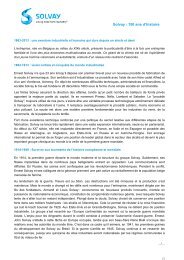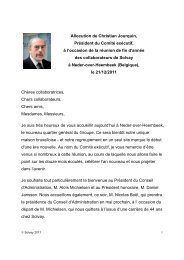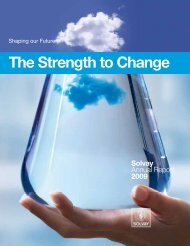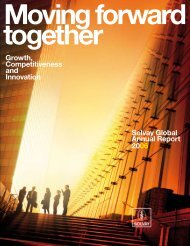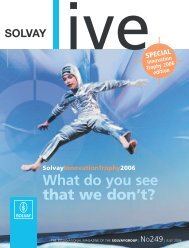Financial Statements - Solvay
Financial Statements - Solvay
Financial Statements - Solvay
You also want an ePaper? Increase the reach of your titles
YUMPU automatically turns print PDFs into web optimized ePapers that Google loves.
64<br />
<strong>Solvay</strong> Global Annual Report 2008<br />
5. Retirement benefi t costs<br />
The Group operates a number of defi ned benefi t and<br />
defi ned contribution retirement benefi t plans. Payments to<br />
defi ned contribution retirement benefi t plans are charged<br />
as an expense as they fall due.<br />
The Group’s commitments under defi ned benefi ts plans,<br />
and the related costs, are valued using the “projected unit<br />
credit method” in order to determine the present value of<br />
the obligation at closing date.<br />
The amount recorded in the balance sheet represents<br />
the present value of the defi ned benefi t obligations,<br />
adjusted for actuarial differences, for unrecognized past<br />
service costs and for the fair value of external plan assets,<br />
limited in the case of a surplus to the present value of<br />
available refunds and/or reductions in future contributions.<br />
Actuarial differences exceeding the higher of 10 % of<br />
the present value of the retirement benefi t obligations<br />
and 10 % of the fair value of the assets of the external<br />
plan assets at balance sheet closing date are amortized<br />
over the expected average remaining working life of<br />
the participating employees.<br />
6. Non-recurring items<br />
Non-recurring items mainly include:<br />
• gains and losses on the sale of subsidiaries, jointventures,<br />
affi liates accounted for under the equity<br />
method that do not qualify as discontinued operations,<br />
and available-for-sale investments; gains and losses on<br />
the sale of real estate not directly linked to an operating<br />
activity;<br />
• restructuring charges associated with the shutdown of<br />
an activity;<br />
• impairment of tangible assets, intangible assets and<br />
goodwill associated with the shutdown of an activity and/<br />
or a restructuring plan;<br />
• the impact of signifi cant litigation.<br />
7. Income taxes<br />
Income taxes on profi ts for the period include both<br />
current and deferred taxes. They are recorded in<br />
the income statement except where they relate to items<br />
recorded directly in equity, in which case they too are<br />
recorded in equity.<br />
Current taxes are taxes payable on the taxable profi t<br />
for the period, calculated at the tax rates prevailing<br />
at the balance sheet closing date, as well as adjustments<br />
relating to previous periods.<br />
Deferred tax assets and liabilities are required to be<br />
measured at the tax rates that are expected to apply to<br />
the fi nancial year in which the asset is realized or the liability<br />
is settled, based on tax rates (and tax laws) that have been<br />
enacted or substantively enacted by the balance sheet date.<br />
Deferred tax liabilities relating to subsidiaries’ profi ts that<br />
the Group does not intend distributing in the foreseeable<br />
future are not accounted for.<br />
Deferred tax assets are recognized only where taxable<br />
profi ts are likely to be realized, against which the deferred<br />
tax assets will be imputed.<br />
8. Tangible and intangible assets<br />
Tangible and intangible assets are carried at their historical<br />
cost less depreciation/amortization. Depreciation/<br />
amortization is included in the income statement under<br />
cost of goods sold, commercial and administrative costs,<br />
and in R&D costs.<br />
Depreciation/amortization is calculated on a straight-line<br />
basis, according to the useful life listed below:<br />
Buildings 30 years<br />
IT equipment 3 - 5 years<br />
Machinery and equipment 10 - 20 years<br />
Transportation equipment 5 - 20 years<br />
Development costs 2 - 5 years<br />
Patents, trademarks<br />
and other intangible assets<br />
5 - 20 years<br />
Assets held under fi nance leases are initially recognized as<br />
assets at the lower of their fair value or the present value<br />
of the minimum lease payments related to the contracts.<br />
The corresponding liability is included in fi nancial debts.<br />
<strong>Financial</strong> charges, representing the difference between<br />
the full amount of the lease obligations and the fair<br />
value of the assets acquired, are charged to the income<br />
statement over the duration of the contract. Agreements<br />
not in the legal form of a lease contract are analyzed<br />
with reference to IFRIC 4 to determine whether or not<br />
they contain a leasing contract to be accounted for<br />
in accordance with IAS 17.<br />
Borrowing costs directly attributable to the acquisition,<br />
construction or production of an asset requiring a long<br />
preparation period are added to the cost of this asset until<br />
it is ready for use.<br />
Grants for the purchase of assets are recorded net of<br />
the value of these assets.


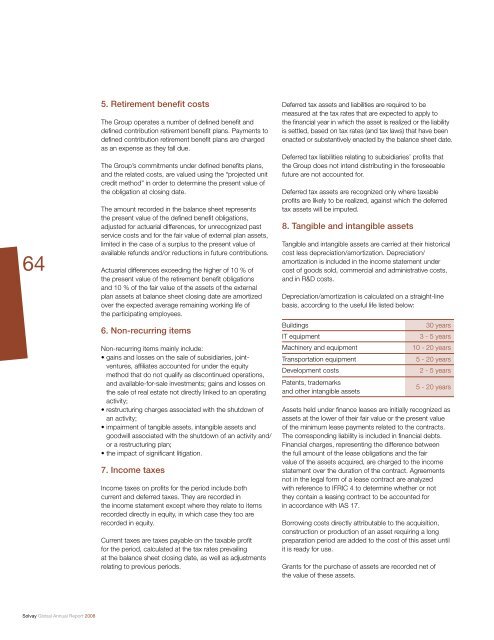

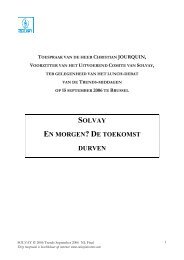
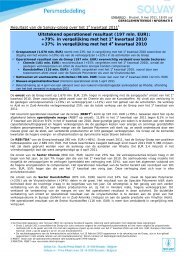

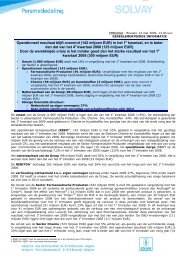
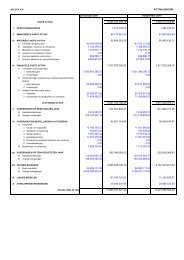


![PROC.1 [LETTRE] - Solvay](https://img.yumpu.com/16585746/1/184x260/proc1-lettre-solvay.jpg?quality=85)
